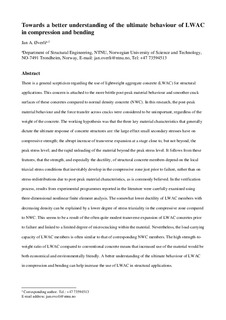| dc.contributor.author | Øverli, Jan Arve | |
| dc.date.accessioned | 2017-11-21T13:26:26Z | |
| dc.date.available | 2017-11-21T13:26:26Z | |
| dc.date.created | 2017-09-12T13:22:54Z | |
| dc.date.issued | 2017 | |
| dc.identifier.citation | Engineering structures. 2017, 151 821-838. | nb_NO |
| dc.identifier.issn | 0141-0296 | |
| dc.identifier.uri | http://hdl.handle.net/11250/2467379 | |
| dc.description.abstract | There is a general scepticism regarding the use of lightweight aggregate concrete (LWAC) for structural applications. This concern is attached to the more brittle post-peak material behaviour and smoother crack surfaces of these concretes compared to normal density concrete (NWC). In this research, the post-peak material behaviour and the force transfer across cracks were considered to be unimportant, regardless of the weight of the concrete. The working hypothesis was that the three key material characteristics that generally dictate the ultimate response of concrete structures are: the large effect small secondary stresses have on compressive strength; the abrupt increase of transverse expansion at a stage close to, but not beyond, the peak stress level; and the rapid unloading of the material beyond the peak stress level. It follows from these features, that the strength, and especially the ductility, of structural concrete members depend on the local triaxial stress conditions that inevitably develop in the compressive zone just prior to failure, rather than on stress-redistributions due to post-peak material characteristics, as is commonly believed. In the verification process, results from experimental programmes reported in the literature were carefully examined using three-dimensional nonlinear finite element analysis. The somewhat lower ductility of LWAC members with decreasing density can be explained by a lower degree of stress triaxiality in the compressive zone compared to NWC. This seems to be a result of the often quite modest transverse expansion of LWAC concretes prior to failure and linked to a limited degree of microcracking within the material. Nevertheless, the load-carrying capacity of LWAC members is often similar to that of corresponding NWC members. The high strength-to-weight ratio of LWAC compared to conventional concrete means that increased use of the material would be both economical and environmentally friendly. A better understanding of the ultimate behaviour of LWAC in compression and bending can help increase the use of LWAC in structural applications. | nb_NO |
| dc.language.iso | eng | nb_NO |
| dc.publisher | Elsevier | nb_NO |
| dc.rights | Attribution-NonCommercial-NoDerivatives 4.0 Internasjonal | * |
| dc.rights.uri | http://creativecommons.org/licenses/by-nc-nd/4.0/deed.no | * |
| dc.title | Towards a better understanding of the ultimate behaviour of LWAC in compression and bending | nb_NO |
| dc.type | Journal article | nb_NO |
| dc.type | Peer reviewed | nb_NO |
| dc.description.version | acceptedVersion | nb_NO |
| dc.source.pagenumber | 821-838 | nb_NO |
| dc.source.volume | 151 | nb_NO |
| dc.source.journal | Engineering structures | nb_NO |
| dc.identifier.doi | 10.1016/j.engstruct.2017.08.063 | |
| dc.identifier.cristin | 1493028 | |
| dc.description.localcode | © 2017. This is the authors’ accepted and refereed manuscript to the article. LOCKED until 12.9.2019 due to copyright restrictions. This manuscript version is made available under the CC-BY-NC-ND 4.0 license http://creativecommons.org/licenses/by-nc-nd/4.0/ | nb_NO |
| cristin.unitcode | 194,64,45,0 | |
| cristin.unitname | Institutt for konstruksjonsteknikk | |
| cristin.ispublished | true | |
| cristin.fulltext | postprint | |
| cristin.qualitycode | 2 | |

